
Schuylkill County is a county in the Commonwealth of Pennsylvania. As of the 2020 census, the population was 143,049. The county seat is Pottsville. The county is part of the Northeast Pennsylvania region of the state.

The Chesapeake & Delaware Canal is a 14-mile (22.5 km)-long, 450-foot (137.2 m)-wide and 35-foot (10.7 m)-deep ship canal that connects the Delaware River with the Chesapeake Bay in the states of Delaware and Maryland in the United States.
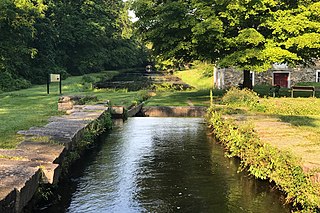
The Morris Canal (1829–1924) was a 107-mile (172 km) common carrier anthracite coal canal across northern New Jersey that connected the two industrial canals in Easton, Pennsylvania across the Delaware River from its western terminus at Phillipsburg, New Jersey to New York Harbor and New York City through its eastern terminals in Newark and on the Hudson River in Jersey City. The canal was sometimes called the Morris and Essex Canal, in error, due to confusion with the nearby and unrelated Morris and Essex Railroad.

Manayunk is a neighborhood in the section of Lower Northwest Philadelphia in the state of Pennsylvania. Located adjacent to the neighborhoods of Roxborough and Wissahickon and also on the banks of the Schuylkill River, Manayunk contains the first canal begun in the United States.
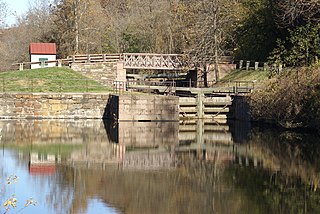
The Schuylkill Canal, or Schuylkill Navigation, was a system of interconnected canals and slack-water pools along the Schuylkill River in the U.S. state of Pennsylvania, built as a commercial waterway in the early 19th-century. Chartered in 1815, the navigation opened in 1825, to provide transportation and water power.
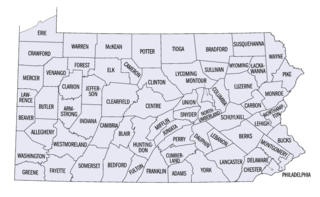
This is a list of properties and districts listed on the National Register of Historic Places in Pennsylvania. As of 2015, there are over 3,000 listed sites in Pennsylvania. All 67 counties in Pennsylvania have listings on the National Register.

The Lehigh Canal is a navigable canal that begins at the mouth of Nesquehoning Creek on the Lehigh River in the Lehigh Valley and Northeastern regions of Pennsylvania. It was built in two sections over a span of 20 years beginning in 1818. The lower section spanned the distance between Easton and present-day Jim Thorpe. In Easton, the canal met the Pennsylvania Canal's Delaware Division and Morris Canals, which allowed anthracite coal and other goods to be transported further up the U.S. East Coast. At its greatest extent, the Lehigh Canal was 72 miles (116 km) long.

Lehigh Gorge State Park is a 4,548 acres (1,841 ha) Pennsylvania state park in Luzerne and Carbon Counties, Pennsylvania. The park encompasses a gorge, which stretches along the Lehigh River from a U.S. Army Corps of Engineers flood control dam in Luzerne County to Jim Thorpe in Carbon County.
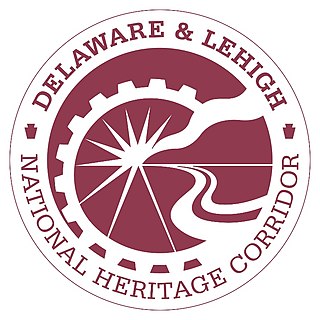
Delaware & Lehigh Canal National and State Heritage Corridor (DLNHC) is a 165-mile (266 km) National Heritage Area in eastern Pennsylvania in the United States. It stretches from north to south, across five counties and over one hundred municipalities. It follows the historic routes of the Lehigh and Susquehanna Railroad, Lehigh Valley Railroad, the Lehigh Navigation, Lehigh Canal, and the Delaware Canal, from Bristol northeast of Philadelphia to Wilkes-Barre in the northeastern part of the state.

The North Canal Historic District of Lawrence, Massachusetts, encompasses the historic industrial heart of the city. It is centered on the North Canal and the Great Stone Dam, which provided the waterpower for its many mill complexes. The canal was listed on the National Register of Historic Places in 1975, while the district was first listed in 1984, and then expanded slightly in 2009.

South Ann Street–Mill Street Historic District is a national historic district located at Little Falls in Herkimer County, New York. The district includes 15 contributing buildings and one contributing structure. They relate to the history of transportation and commercial/industrial development of the city. They include multi-story brick and stone commercial buildings, the former New York Central Railroad passenger station, remains of Erie Canal trunk and aqueduct, and a former hydroelectric power station and remains of the related dam.

Lehigh Coal & Navigation Company was a mining and transportation company headquartered in Mauch Chunk, now known as Jim Thorpe, Pennsylvania. The company operated from 1818 until its dissolution in 1964 and played an early and influential role in the American Industrial Revolution.
Coal River Locks, Dams, and Log Booms Archeological District is a national historic district and historic archaeological site located on the Coal River in Boone, Lincoln, and Kanawha County, West Virginia. It consists of an underwater resource depicting the navigation and transportation system used on the Coal River during the late-19th and early-20th century. It includes remains of timber cribs, locks and dams, and a lock master house. It was designed by William Rosecrans in the mid-1850s, and was one of the first complete lock and dam systems in West Virginia.

Josiah White (1781–1850) was a Pennsylvania industrialist and key figure in the American Industrial Revolution.
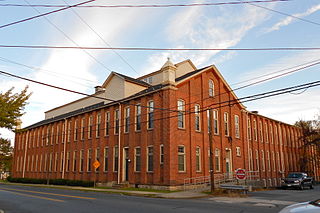
Biery's Port Historic District is a national historic district located in Catasauqua, Pennsylvania in the Lehigh Valley region of eastern Pennsylvania. The district was added to the National Register of Historic Places in 1984 and includes 90 contributing buildings in the Biery's Port section of Catasauqua.

Ashley Planes was a historic freight cable railroad situated along three separately powered inclined plane sections located between Ashley, Pennsylvania at the foot, and via the Solomon cutting the yard in Mountain Top over 1,000 feet (300 m) above and initially built between 1837 and 1838 by Lehigh Coal & Navigation Company's subsidiary Lehigh and Susquehanna Railroad (L&S).

The Bear Creek Village Historic District is a national historic district located in Bear Creek Village, Luzerne County, Pennsylvania. The district includes fifty-five contributing buildings, four contributing sites and two contributing structures in the borough of Bear Creek Village.

The Swatara Furnace is a historic iron furnace and 200-acre national historic district located along Mill Creek, a tributary of the Swatara Creek in Pine Grove Township, Schuylkill County, Pennsylvania.

The Pine Forge Mansion and Industrial Site, also known as Thomas Rutter's Mansion and the Pine Forge Iron Plantation, is an historic, American iron plantation and mansion and national historic district located in Douglass Township, Berks County, Pennsylvania.
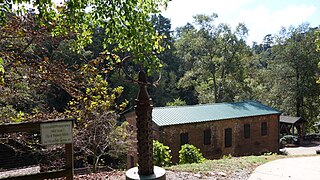
The Roswell Historic District, in Roswell, Georgia in Fulton County, was listed on the National Register of Historic Places in 1974.























